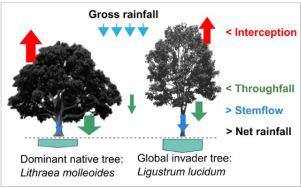当前位置:
X-MOL 学术
›
Agric. For. Meteorol.
›
论文详情
Our official English website, www.x-mol.net, welcomes your feedback! (Note: you will need to create a separate account there.)
Advantages of rainfall partitioning by the global invader Ligustrum lucidum over the dominant native Lithraea molleoides in a dry forest
Agricultural and Forest Meteorology ( IF 6.2 ) Pub Date : 2020-08-01 , DOI: 10.1016/j.agrformet.2020.108013 Juan I. Whitworth-Hulse , Patricio N. Magliano , Sebastián R. Zeballos , Diego E. Gurvich , Florencia Spalazzi , Esteban Kowaljow
Agricultural and Forest Meteorology ( IF 6.2 ) Pub Date : 2020-08-01 , DOI: 10.1016/j.agrformet.2020.108013 Juan I. Whitworth-Hulse , Patricio N. Magliano , Sebastián R. Zeballos , Diego E. Gurvich , Florencia Spalazzi , Esteban Kowaljow

|
Abstract Vegetation canopy plays a key role in the local water balance by partitioning rainfall into interception, throughfall and stemflow in dry forests. Many invasive plants have the capacity to replace native species and alter the net amount and spatial distribution of rainfall reaching the soil. In this paper, we aimed to compare the rainfall partitioning for the invader Ligustrum lucidum and the dominant native Lithraea molleoides, to evaluate the influence of morphological characteristics on stemflow generation in both species, and to explore spatio-temporal patterns of throughfall at stand scale. Stemflow percentage for L. lucidum was hugely higher than for L. molleoides (18 and 1%, respectively), which overcompensated its lower throughfall percentage (58.1 and 68.6%, respectively). Interception losses were lower for L. lucidum than for L. molleoides (23.2 and 30.6%, respectively). The minimum rainfall amount needed to generate throughfall and stemflow was 1.8 and 0.5 mm for L. lucidum, while 2.2 and 7.2 mm for L. molleoides. The differences in morphological characteristics between species mainly explained the stemflow generation. The increment on tree basal area, projected canopy area, and number of branches favored stemflow in L. lucidum, but not in L. molleoides. The throughfall spatial patterns showed that the dripping from different canopy densities was homogenous in L. lucidum stands, whereas throughfall increase towards more opened-canopies in L. molleoides stands. Lateral inflows were registered from small-scale crown sections at both forest stands, but less frequent in L. lucidum stands. The time stability of throughfall pattern differed between forest stands. Based on our results, relatively higher stemflow and lower interception losses for L. lucidum than for L. Molleoides may represent a competitive advantage in terms of plant invasion in water-limited ecosystems. These findings highlight the need for further inquiries determining the underlying role of rainfall partitioning in the invasion process of woody species.
中文翻译:

全球入侵者 Ligustrum lucidum 对干旱森林中占优势的原生 Lithraea molleoides 进行降雨分配的优势
摘要 植被冠层通过将干旱森林中的降雨划分为截留、直通和茎流,在当地的水平衡中发挥着关键作用。许多入侵植物有能力取代本地物种并改变到达土壤的降雨的净量和空间分布。在本文中,我们旨在比较入侵者 Ligustrum lucidum 和占优势的本地 Lithraea molleoides 的降雨分配,评估形态特征对两种物种茎流生成的影响,并探索林分尺度的直通量时空模式。L. lucidum 的茎流百分比远高于 L. molleoides(分别为 18% 和 1%),这超过了其较低的通过百分比(分别为 58.1% 和 68.6%)。灵芝的截获损失低于灵芝。molleoides(分别为 23.2% 和 30.6%)。L. lucidum 产生贯通和茎流所需的最小降雨量为 1.8 和 0.5 mm,而 L. molleoides 为 2.2 和 7.2 mm。种间形态特征的差异主要解释了茎流的产生。树基面积、预计冠层面积和分枝数量的增加有利于灵芝的茎流,但不利于 L. molleoides。通水空间格局表明,灵芝林分不同冠层密度的滴水是同质的,而通水量在灵芝林分向更多开放的冠层增加。两个林分的小规模树冠部分都有横向流入,但灵芝林分较少。林分间贯流模式的时间稳定性不同。根据我们的研究结果,灵芝相对较高的茎流和较低的截留损失可能代表了在水分有限的生态系统中植物入侵方面的竞争优势。这些发现强调了进一步调查确定降雨分配在木本物种入侵过程中的潜在作用的必要性。
更新日期:2020-08-01
中文翻译:

全球入侵者 Ligustrum lucidum 对干旱森林中占优势的原生 Lithraea molleoides 进行降雨分配的优势
摘要 植被冠层通过将干旱森林中的降雨划分为截留、直通和茎流,在当地的水平衡中发挥着关键作用。许多入侵植物有能力取代本地物种并改变到达土壤的降雨的净量和空间分布。在本文中,我们旨在比较入侵者 Ligustrum lucidum 和占优势的本地 Lithraea molleoides 的降雨分配,评估形态特征对两种物种茎流生成的影响,并探索林分尺度的直通量时空模式。L. lucidum 的茎流百分比远高于 L. molleoides(分别为 18% 和 1%),这超过了其较低的通过百分比(分别为 58.1% 和 68.6%)。灵芝的截获损失低于灵芝。molleoides(分别为 23.2% 和 30.6%)。L. lucidum 产生贯通和茎流所需的最小降雨量为 1.8 和 0.5 mm,而 L. molleoides 为 2.2 和 7.2 mm。种间形态特征的差异主要解释了茎流的产生。树基面积、预计冠层面积和分枝数量的增加有利于灵芝的茎流,但不利于 L. molleoides。通水空间格局表明,灵芝林分不同冠层密度的滴水是同质的,而通水量在灵芝林分向更多开放的冠层增加。两个林分的小规模树冠部分都有横向流入,但灵芝林分较少。林分间贯流模式的时间稳定性不同。根据我们的研究结果,灵芝相对较高的茎流和较低的截留损失可能代表了在水分有限的生态系统中植物入侵方面的竞争优势。这些发现强调了进一步调查确定降雨分配在木本物种入侵过程中的潜在作用的必要性。



























 京公网安备 11010802027423号
京公网安备 11010802027423号